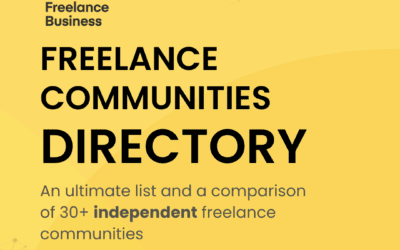Below, we’ve listed the most effective ways for freelance graphic designers to find clients online.
1. Build a portfolio
As a freelance graphic designer, your most valuable asset in a saturated designer market with so many options is your professional talent and references. However skilled and creative you are, if you don’t have a platform to showcase this to new potential clients, it will be much harder to win them over.
Last on the priority list of many graphic designers is the creation of their own website or portfolio. Usually there is no time for it (which might be a good sign, because you have enough work), but in the long run and for development (e.g. if you are expanding internationally) it is essential.
You don’t need to be a web developer, having your own profile on a suitable online platform is perfect. Behance is probably one of the best-known ones, but you can also check out Portfoliobox, where you can build your own site, or DeviantArt, where illustrators are most at home. But if you’d like to create a website, you can read our article here: Website for Freelance Business: The Complete Guide for Freelancers.
2. Be present in the community
Of all the online marketplaces, it is probably the easiest to be present on social networking sites, watch for graphic design client posts and respond as soon as possible. However, this can often seem like a real struggle, and I often get discouraged from applying if nineteen people have already responded to a particular enquiry before me. That said, it never hurts to introduce yourself and include your portfolio. As well as getting the employer’s attention, the rest of the group will also get to know you a bit, so they can look back on your response later and find you by looking at previous posts and hashtags before they post a question.
The most common response to a post is “I sent you a PM”. This is only information for the person who asked the question. Use this sample instead: “Dear XY, I’ve worked on a project with a similar theme before and would be happy to help you with the design you’re requesting. I have sent you a private message, where we can discuss further details if there is mutual sympathy – www.[portfolio_name].com”
The above might sound a bit pushy, but there are two important things: one is that you have relevant experience (for me as a project manager this is always very reassuring), and the other is the availability of your portfolio, which, even if this deal doesn’t work out, will always be retrievable and accessible.
And, if you’ve already promised, drop him/her a private message, in which you might – if your time and enthusiasm allows – include a personal thought or two. It always makes a wonderful first impression when I see that someone who writes to me is looking into a particular topic, commenting on e.g. what they see on my website (only positive thoughts at first) and providing relevant information.
Talking about communities: make sure you join the mailing list of Freelance Business Community and our Slack. For further advice read our article about How to choose your freelance community?
3. Move in to online job sites
The Internet offers a wealth of opportunities where you can build your own profile as a graphic designer and reach your own specific target audience. This usually involves a lot more work than a Facebook presence, but if you get to know a few platforms and get some good references from that platform, you can expand your client base and great job opportunities will be easier to find.
It’s worth looking at which job sites best match your professional experience and personality and focusing on a maximum of 1-2 of these sites first, building your own personal brand here.
Global job websites are home to a wide range of online industries, as a graphic designer you should also do a little research on The Indie List too. This is the go-to platform for businesses seeking the best freelance talent in the marketing and creative industries.
4. Specialise
Today, we’re no longer just looking for a graphic designer for a project, but also a UX artist, UI artist, illustrator, brand identity designer, web designer or even a comic artist. As a client, it’s important to know whether the graphic designer applying for a particular position has the skill set we need. Once you know what your superpower is, it’s worth highlighting it in your portfolio and in the message you send when applying for a project.
Another specialisation could be a specific topic or area you know well. It may be that you have produced several tourism-themed graphics in the past, and if you include them all in your portfolio, it will be clear that you are familiar with this area. It’s worth using this to your advantage by looking for new clients specifically focused on this area, so your portfolio will grow in this theme, and you’ll be able to attract clients from across the industry.
Would you like to learn more about sales, marketing and branding? Download our free Freelance Business Book.
5. Collect feedback
When it comes to your own work, the only thing that rings more true for your clients are the words of praise from previous clients. After every collaboration, thank them for their work and preferably hold a short project review meeting where you and your client can give feedback on the work together. This will leave no one feeling bad (you can discuss how you can improve your work together in the future) and prepare for a possible next joint project.
If you can get the client to give you some written feedback, you can really enrich your portfolio. Make a very short satisfaction survey (e.g. using Google form) and send it out after the project is finished. Include a free text form field where your client can write a few sentences that you can put in the Reviews block on your website, if you wish (before you do, of course, indicate on the form that you would like to use it on the website).
6. Build a long-term customer relationship
In the previous point, I already mentioned how you should evaluate the project with the client or even with colleagues, because every time you learn something new, it will help you to work together more smoothly in the future.
Another basic principle of a long-term client relationship is that to stay in touch, you need to hear from each other from time to time. If no new work comes up, you may not talk to each other for months, which is fine, but with each passing week and month the chances increase that if a new opportunity does come along at some point, you won’t be on the client’s mind enough to remember to contact you.
To avoid this, it’s a good idea to check in every now and then. To do this, it’s good to know the client and their needs. If, for example, you are designing a website with a nice big carousel on the landing page, they might need a new graphic sometimes. Before a major holiday, you can ask how they are, how the new website is doing and whether they need a new set of carousels. Or, if you’ve designed a newsletter, and you know that they’ve renewed the software they use to send it out (e.g. Mailchimp), you can indicate that the system has new graphics templates and if they feel the need, you’d be happy to design them a fresh newsletter to match. Be a bit cheery, sometimes even a tiny bit pushy, and you’ll get a sense of whether there’s openness or a rather shaky response (or no response at all). In the latter case, of course, this is not the way to go with them.
In addition to the above, you can also improve your memory and memorise information such as the name of the customer’s puppy or birthday. Every little bit of attention is appreciated. Learn here how you can create a regular income with Ross Welch.
7. Improve yourself
It goes without saying that, as with all digital professions, technology is evolving every day for graphic designers. Anyone who refused to switch from Adobe Flash to more modern tools was in big trouble, because, unfortunately, they couldn’t serve anyone, no matter how much of a Flash wizard they were.
For us, the ability to innovate will always be fundamental. So whether you choose to self-train, develop yourself through an online platform (e.g. Udemy, Skillshare, Coursera, see more here), or attend conferences and exchange ideas with other graphic designers, you definitely do something for your career.
8. Get on a team
You may be comfortable being a lone wolf and have a well-established client base, but if you enjoy working in a team and your professionalism warrants collaboration (because let’s say you’re a web designer), it’s worth teaming up with a project manager, developer, copywriter so you can take on more projects together and avoid competing with teams who can solve all your client’s needs in one go.
As a freelancer, it’s natural to be reluctant to commit to a fixed community for the long term, but you don’t necessarily have to get together straight away either. It’s enough to have a live relationship between you, and when a new opportunity comes along, you decide who gets involved in what way.
Another way to work together is to each take on a project as an individual, but where possible, you can refer each other to a project, so you can work with someone you know well and the project will be smoother and less risky.
9. Take on small jobs
If it’s pickle season, you can take on work that you might otherwise turn down because it doesn’t pay as well or takes up space on a project that would pay for the longer term. A small job, while it may not get you excited, can help you build or maintain relationships that could be lucrative later on.
There’s nothing worse than grinding away at home and waiting for your dream job to find you. One of the great advantages of freelancing is that we decide where to draw the line, what kind of work we take on and how much it pays. We can also feel free to override our own decisions if, at any given moment, another path seems rational. Who knows what this path might bring in the long run.
10. Volunteer
Volunteering is uplifting, it builds your spirit and strengthens your relationships. So many small organisations don’t have the budget to get their message across to their community in the right way, so they struggle to campaign or fundraise for their causes.
If there are organisations you’d like to support, a good graphic might help them much more than a few thousand dollars. If you are looking to build a portfolio, reach out to them, offer your help. As well as feeling good, your number of referrals and professional recognition will increase.




